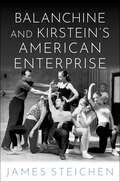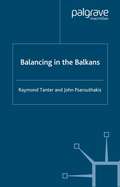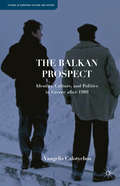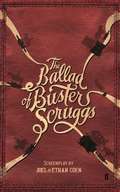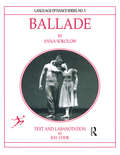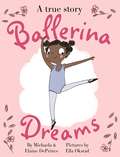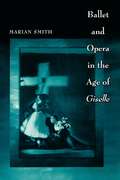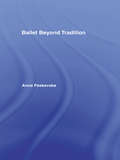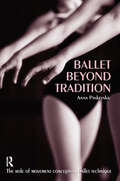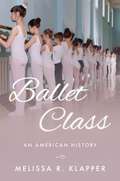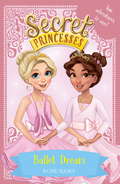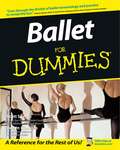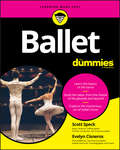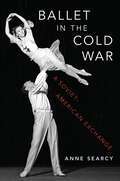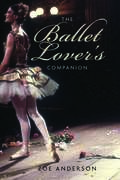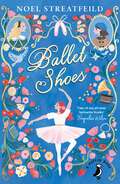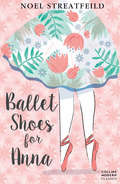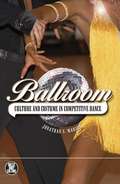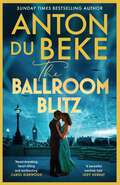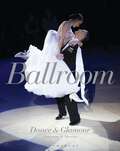- Table View
- List View
Balanchine and Kirstein's American Enterprise
by James SteichenIn 1933 choreographer George Balanchine and impresario Lincoln Kirstein embarked on an elusive quest to found a ballet company and school in the United States. Though their efforts would eventually result in the creation of the New York City Ballet and the School of American Ballet, the first decade of their collaborative efforts was anything but assured. Tracing the tangled histories of two of the most important figures in twentieth-century dance, Balanchine and Kirstein's American Enterprise offers a fresh perspective on a pivotal period in cultural history. Deeply researched using sources only made available in recent years, the book challenges the mythologies surrounding the early years of the Balanchine-Kirstein enterprise. It also reveals the full extent of Kirstein's essential role and offers reconstructive analysis of lost works, as well as new and surprising details regarding some of Balanchine's most iconic ballets, including Serenade, Apollo, and Concerto Barocco. This history involved artists including Richard Rodgers, Martha Graham, George Gershwin, Katherine Dunham, Vera Zorina, and Igor Stravinsky, as well as dozens of lesser known players whose contributions have yet to be fully acknowledged. Capturing the full sweep of Balanchine and Kirstein's collaborative work across multiple genres and institutions, this book reveals their partnership in all of its exciting and ungainly complexity, showing how the 1930s Balanchine was not the artist that he would eventually become, and how the same was true of the institutions that he and Kirstein jointly created.
Balancing in the Balkans
by R. Tanter J. PsarouthakisBalancing in the Balkans explores the region for ideas concerning globalism, the creation of transnational economic communities from capital flows across political boundaries, tribalism, and the disintegration of nations into ethnic factions based upon ancient hatreds. In this book, Tanter and Psarouthakis debate the best way to achieve 'balance' - how parties in conflict can learn moderation and peaceful coexistence.
The Balkan Prospect: Identity, Culture, and Politics in Greece after 1989 (Studies in European Culture and History)
by V. CalotychosFollowing the fall of the Soviet Union in 1989, the borders hitherto separating Greek culture and society from its contiguous Balkan polities came down, and Greeks had to reorient themselves toward their immediate neighbors and redefine their place within Europe and the new, more fluid global order. Projecting the political foresight and mustering the modernization policies to succeed in such an undertaking turned out to be no small feat, especially as the regional conflicts that had lain dormant during the Cold War were revived. Synthesizing the cultural, political, and historical into a sophisticated, interdisciplinary analysis, this innovative study untangles the prolonged 'historical moment' in which Greece and Europe were effectively held hostage to events in the Balkans - just at the time when both hoped to serve as the region's welcoming hosts.
The Ballad of Buster Scruggs
by Joel Coen & Ethan CoenDeath is always the issue-in life, and in the Western. Joel and Ethan Coen's The Ballad of Buster Scruggs is a movie of six Western stories. In each, our common destination is approached by a different road. Through each, diverse characters hurry for their final appointment: Oregon Trail-travelers, a gold prospector, a motley crew of stagecoach passengers, a high-plains drifting bank robber, even a singing cowboy. These six stories escort them with a care that either respects, or mocks, the dignity of all.The film stars Tom Waits, James Franco, Liam Neeson, Tim Bake Nelson and Zoe Kazan and is shot with the harsh grandeur of the classic John Ford westerns.
Ballade by Anna Sokolow (Language of Dance)
by Ray CookFirst Published in 1993. Routledge is an imprint of Taylor & Francis, an informa company.
Ballade by Anna Sokolow (Language of Dance #No. 5)
by Ray CookFirst Published in 1993. Routledge is an imprint of Taylor & Francis, an informa company.
Ballerina Dreams: From Orphan To Dancer (Step Into Reading: Step 4 Ser.)
by Michaela DePrinceOne windy day, a magazine blew down the road. I reached out and caught it. A pretty picture of a woman was on the front cover of the magazine. She wore a short pink dress that stuck out around her in a circle. She looked very happy.At the age of three, Michaela DePrince found a photo of a ballerina that changed her life. She was living in an orphanage in Sierra Leone at the time, but was soon adopted by a family and brought to America. Michaela never forgot the photo of the dancer she once saw, and decided to make her dream of becoming a ballerina come true. She has been dancing ever since, and after a spell as a principal dancer in New York, now dances for the Dutch National Ballet in Amsterdam.Beautifully and gently illustrated by Ella Okstad, Ballerina Dreams is the younger-reader edition of Michaela DePrince's highly moving memoir, Hope in a Ballet Shoe.
Ballet and Opera in the Age of "Giselle" (PDF)
by Marian SmithMarian Smith recaptures a rich period in French musical theater when ballet and opera were intimately connected. Focusing on the age of Giselle at the Paris Opéra (from the 1830s through the 1840s), Smith offers an unprecedented look at the structural and thematic relationship between the two genres. She argues that a deeper understanding of both ballet and opera--and of nineteenth-century theater-going culture in general--may be gained by examining them within the same framework instead of following the usual practice of telling their histories separately. This handsomely illustrated book ultimately provides a new portrait of the Opéra during a period long celebrated for its box-office successes in both genres. Smith begins by showing how gestures were encoded in the musical language that composers used in ballet and in opera. She moves on to a wide range of topics, including the relationship between the gestures of the singers and the movements of the dancers, and the distinction between dance that represents dancing (entertainment staged within the story of the opera) and dance that represents action. Smith maintains that ballet-pantomime and opera continued to rely on each other well into the nineteenth century, even as they thrived independently. The "divorce" between the two arts occurred little by little, and may be traced through unlikely sources: controversies in the press about the changing nature of ballet-pantomime music, shifting ideas about originality, complaints about the ridiculousness of pantomime, and a little-known rehearsal score for Giselle. ?
Ballet Beyond Tradition
by Anna PaskevskaFor nearly a century, the training of ballet and modern dancers has followed two divergent paths. Modern practitioners felt ballet was artificial and injurious to the body; ballet teachers felt that modern dancers lacked the rigorous discipline and control that comes only from years of progressive training. Ballet Beyond Tradition seeks to reconcile these age-old conflicts and bring a new awareness to ballet teachers of the importance of a holistic training regimen that draws on the best that modern dance and movement-studies offers.
Ballet Beyond Tradition
by Anna PaskevskaFor nearly a century, the training of ballet and modern dancers has followed two divergent paths. Modern practitioners felt ballet was artificial and injurious to the body; ballet teachers felt that modern dancers lacked the rigorous discipline and control that comes only from years of progressive training. Ballet Beyond Tradition seeks to reconcile these age-old conflicts and bring a new awareness to ballet teachers of the importance of a holistic training regimen that draws on the best that modern dance and movement-studies offers.
Ballet Class: An American History
by Melissa R. KlapperSurveying the state of American ballet in a 1913 issue of McClure's Magazine, author Willa Cather reported that few girls expressed any interest in taking ballet class and that those who did were hard-pressed to find anything other than dingy studios and imperious teachers. One hundred years later, ballet is everywhere. There are ballet companies large and small across the United States; ballet is commonly featured in film, television, literature, and on social media; professional ballet dancers are spokespeople for all kinds of products; nail polish companies market colors like "Ballet Slippers" and "Prima Ballerina;" and, most importantly, millions of American children have taken ballet class. Beginning with the arrival of Russian dancers like Anna Pavlova, who first toured the United States on the eve of World War I, Ballet Class: An American History explores the growth of ballet from an ancillary part of nineteenth-century musical theater, opera, and vaudeville to the quintessential extracurricular activity it is today, pursued by countless children nationwide and an integral part of twentieth-century American childhood across borders of gender, class, race, and sexuality. A social history, Ballet Class takes a new approach to the very popular subject of ballet and helps ground an art form often perceived to be elite in the experiences of regular, everyday people who spent time in barre-lined studios across the United States. Drawing on a wide variety of materials, including children's books, memoirs by professional dancers and choreographers, pedagogy manuals, and dance periodicals, in addition to archival collections and oral histories, this pathbreaking study provides a deeply-researched national perspective on the history and significance of recreational ballet class in the United States and its influence on many facets of children's lives, including gender norms, consumerism, body image, children's literature, extracurricular activities, and popular culture.
Ballet Class: An American History
by Melissa R. KlapperSurveying the state of American ballet in a 1913 issue of McClure's Magazine, author Willa Cather reported that few girls expressed any interest in taking ballet class and that those who did were hard-pressed to find anything other than dingy studios and imperious teachers. One hundred years later, ballet is everywhere. There are ballet companies large and small across the United States; ballet is commonly featured in film, television, literature, and on social media; professional ballet dancers are spokespeople for all kinds of products; nail polish companies market colors like "Ballet Slippers" and "Prima Ballerina;" and, most importantly, millions of American children have taken ballet class. Beginning with the arrival of Russian dancers like Anna Pavlova, who first toured the United States on the eve of World War I, Ballet Class: An American History explores the growth of ballet from an ancillary part of nineteenth-century musical theater, opera, and vaudeville to the quintessential extracurricular activity it is today, pursued by countless children nationwide and an integral part of twentieth-century American childhood across borders of gender, class, race, and sexuality. A social history, Ballet Class takes a new approach to the very popular subject of ballet and helps ground an art form often perceived to be elite in the experiences of regular, everyday people who spent time in barre-lined studios across the United States. Drawing on a wide variety of materials, including children's books, memoirs by professional dancers and choreographers, pedagogy manuals, and dance periodicals, in addition to archival collections and oral histories, this pathbreaking study provides a deeply-researched national perspective on the history and significance of recreational ballet class in the United States and its influence on many facets of children's lives, including gender norms, consumerism, body image, children's literature, extracurricular activities, and popular culture.
Ballet Dream: Two Magical Adventures in One! Special (Secret Princesses #1)
by Rosie BanksSecret Princesses is a gorgeous new series about magical princesses and best friends. In this winter special there are two stories for even more magical fun! Trainee Secret Princesses, Charlotte and Mia, are excited about christmas celebrations at the magical Wishing Star Palace. But evil Princess Poison is determined to spoil everyone's festive fun. Can Charlotte and Mia grant the wishes of two best friends and make sure that their Chrstmas dreams come true?Join Charlotte and Mia in this brilliant adventure full of princess sparkle and seasonal excitement!
Ballet For Dummies (For Dummies)
by Scott Speck Evelyn CisnerosWhether you want to participate in ballet or just watch it, the ballet experience can excite and inspire you. Ballet is among the most beautiful forms of expression ever devised: an exquisite mix of sight and sound, stunning, aesthetics, and awesome technique. Ballet For Dummies is for anyone who wants to enjoy all that the dance forms offers – as an onlooker who wants to get a leg up on the forms you're likely to see or as an exercise enthusiast who understands that the practice of ballet can help you gain More strength Greater flexibility Better body alignment Confidence in movement Comfort through stress reduction Infinite grace – for life From covering the basics of classical ballet to sharing safe and sensible ways to try your hand (and toes) at moving through the actual dance steps, this expert reference shows you how to Build your appreciation for ballet from the ground up. Choose the best practice space and equipment. Warm up to your leap into the movements. Locate musical options for each exercise. Look for certain lifts in a stage performance. Tell a story with gestures. Picture a day in the life of a professional ballet dancer. Identify best-loved classic and contemporary ballets. Speak the language of ballet. Today you can find a ballet company in almost every major city on earth. Many companies have their own ballet schools – some for training future professionals, and others for interested amateurs. As you fine-tune your classical ballet technique – or even if you just like to read about it – you'll become better equipped to fully appreciate the great choreography and many styles of the dance. Ballet For Dummies raises the curtain on a world of beauty, grace, poise, and possibility!
Ballet For Dummies (For Dummies Ser.)
by Scott Speck Evelyn CisnerosWhether you want to participate in ballet or just watch it, the ballet experience can excite and inspire you. Ballet is among the most beautiful forms of expression ever devised: an exquisite mix of sight and sound, stunning, aesthetics, and awesome technique. Ballet For Dummies is for anyone who wants to enjoy all that the dance forms offers – as an onlooker who wants to get a leg up on the forms you're likely to see or as an exercise enthusiast who understands that the practice of ballet can help you gain: More strength Greater flexibility Better body alignment Confidence in movement Comfort through stress reduction Infinite grace – for life From covering the basics of classical ballet to sharing safe and sensible ways to try your hand (and toes) at moving through the actual dance steps, this expert reference shows you how to: Build your appreciation for ballet from the ground up. Choose the best practice space and equipment. Warm up to your leap into the movements. Locate musical options for each exercise. Look for certain lifts in a stage performance. Tell a story with gestures. Picture a day in the life of a professional ballet dancer. Identify best-loved classic and contemporary ballets. Speak the language of ballet. Today you can find a ballet company in almost every major city on earth. Many companies have their own ballet schools – some for training future professionals, and others for interested amateurs. As you fine-tune your classical ballet technique – or even if you just like to read about it – you'll become better equipped to fully appreciate the great choreography and many styles of the dance. Ballet For Dummies raises the curtain on a world of beauty, grace, poise, and possibility! Ballet For Dummies (9781119643104) was previously published as Ballet For Dummies (9780764525681). While this version features a new Dummies cover and design, the content is the same as the prior release and should not be considered a new or updated product.
Ballet For Dummies
by Scott Speck Evelyn CisnerosWhether you want to participate in ballet or just watch it, the ballet experience can excite and inspire you. Ballet is among the most beautiful forms of expression ever devised: an exquisite mix of sight and sound, stunning, aesthetics, and awesome technique. Ballet For Dummies is for anyone who wants to enjoy all that the dance forms offers – as an onlooker who wants to get a leg up on the forms you're likely to see or as an exercise enthusiast who understands that the practice of ballet can help you gain: More strength Greater flexibility Better body alignment Confidence in movement Comfort through stress reduction Infinite grace – for life From covering the basics of classical ballet to sharing safe and sensible ways to try your hand (and toes) at moving through the actual dance steps, this expert reference shows you how to: Build your appreciation for ballet from the ground up. Choose the best practice space and equipment. Warm up to your leap into the movements. Locate musical options for each exercise. Look for certain lifts in a stage performance. Tell a story with gestures. Picture a day in the life of a professional ballet dancer. Identify best-loved classic and contemporary ballets. Speak the language of ballet. Today you can find a ballet company in almost every major city on earth. Many companies have their own ballet schools – some for training future professionals, and others for interested amateurs. As you fine-tune your classical ballet technique – or even if you just like to read about it – you'll become better equipped to fully appreciate the great choreography and many styles of the dance. Ballet For Dummies raises the curtain on a world of beauty, grace, poise, and possibility! Ballet For Dummies (9781119643104) was previously published as Ballet For Dummies (9780764525681). While this version features a new Dummies cover and design, the content is the same as the prior release and should not be considered a new or updated product.
Ballet in the Cold War: A Soviet-American Exchange
by Anne SearcyIn 1959, the Bolshoi Ballet arrived in New York for its first ever performances in the United States. The tour was part of the Soviet-American cultural exchange, arranged by the governments of the US and USSR as part of their Cold War strategies. This book explores the first tours of the exchange, by the Bolshoi in 1959 and 1962, by American Ballet Theatre in 1960, and by New York City Ballet in 1962. The tours opened up space for genuine appreciation of foreign ballet. American fans lined up overnight to buy tickets to the Bolshoi, and Soviet audiences packed massive theaters to see American companies. Political leaders, including Khrushchev and Kennedy, met with the dancers. The audience reaction, screaming and crying, was overwhelming. But the tours also began a series of deep misunderstandings. American and Soviet audiences did not view ballet in the same way. Each group experienced the other's ballet through the lens of their own aesthetics. Americans loved Soviet dancers but believed that Soviet ballets were old-fashioned and vulgar. Soviet audiences and critics likewise appreciated American technique and innovation but saw American choreography as empty and dry. Drawing on both Russian- and English-language archival sources, this book demonstrates that the separation between Soviet and American ballet lies less in how the ballets look and sound, and more in the ways that Soviet and American viewers were trained to see and hear. It suggests new ways to understand both Cold War cultural diplomacy and twentieth-century ballet.
Ballet in the Cold War: A Soviet-American Exchange
by Anne SearcyIn 1959, the Bolshoi Ballet arrived in New York for its first ever performances in the United States. The tour was part of the Soviet-American cultural exchange, arranged by the governments of the US and USSR as part of their Cold War strategies. This book explores the first tours of the exchange, by the Bolshoi in 1959 and 1962, by American Ballet Theatre in 1960, and by New York City Ballet in 1962. The tours opened up space for genuine appreciation of foreign ballet. American fans lined up overnight to buy tickets to the Bolshoi, and Soviet audiences packed massive theaters to see American companies. Political leaders, including Khrushchev and Kennedy, met with the dancers. The audience reaction, screaming and crying, was overwhelming. But the tours also began a series of deep misunderstandings. American and Soviet audiences did not view ballet in the same way. Each group experienced the other's ballet through the lens of their own aesthetics. Americans loved Soviet dancers but believed that Soviet ballets were old-fashioned and vulgar. Soviet audiences and critics likewise appreciated American technique and innovation but saw American choreography as empty and dry. Drawing on both Russian- and English-language archival sources, this book demonstrates that the separation between Soviet and American ballet lies less in how the ballets look and sound, and more in the ways that Soviet and American viewers were trained to see and hear. It suggests new ways to understand both Cold War cultural diplomacy and twentieth-century ballet.
The Ballet Lover's Companion
by Zoe AndersonThis engaging book is a welcome guide to the most successful and loved ballets seen on the stage today. Dance writer and critic Zoe Anderson focuses on 140 ballets, a core international repertory that encompasses works from the ethereal world of romantic ballet to the edgy, muscular works of modern choreographers. She provides a wealth of facts and insights, including information familiar only to dance world insiders, and considers such recent works as Alexei Ramansky's Shostakovich Trilogy and Christopher Wheeldon's The Winter's Tale as well as older ballets once forgotten but now returned to the repertory, such as Sylvia. To enhance enjoyment of each ballet, Anderson also offers tips on what to look for during a performance. Each chapter introduces a period of ballet history and provides an overview of innovations and advancement in the art form. In the individual entries that follow, Anderson includes essential facts about each ballet’s themes, plot, composers, choreographers, dance style, and music. The author also addresses the circumstances of each ballet’s creation and its effect in the theater, and she recounts anecdotes that illuminate performance history and reception. Reliable, accessible, and fully up to date, this book will delight anyone who attends the ballet, participates in ballet, or simply loves ballet and wants to know much more about it.
Ballet Shoes: A Story of Three Children on the Stage (The\shoe Bks. #25)
by Noel StreatfeildPauline, was rescued from a shipwreck as a baby. She longs to be an actress.Petrova, is a Russian orphan. She is happiest when playing with cars and engines.Polly was handed over with just a pair of ballet shoes to her name. If she could, she would dance all day! But one thing they DO have in common is, that with money running out at home and Great Uncle Matthew missing, the sisters want to stay together. Whatever it takes.As they prepare for a dazzling life on stage, the dreams and fears of the fossil girls are about to come true…
Ballet Shoes for Anna (Essential Modern Classics)
by Noel StreatfeildHaving lost their parents in an earthquake, Anna and her siblings live with their prim uncle and feeble aunt. Anna lives only to dance – but her uncle forbids her to have anything to do with ballet. How will she survive?
Ballroom: Culture and Costume in Competitive Dance (Dress, Body, Culture)
by Jonathan S. MarionCompetitive ballroom is much more than a style of dance. Rather, it is a continually evolving and increasingly global social and cultural arena: of fashion, performance, art, sport, gender and more. Ballroom explores the intersection of dance cultures, dress and the body. Presenting the author's experiences at an international range of dance events in Europe, the US and UK, as well as featuring the views of individual dancers, the book shows how dancing influences mind and body alike. For students of anthropology, dance, cultural and performance studies, Ballroom provides an ethnographic picture of how dancers and others live their lives both on and off the dance floor.
Ballroom: Culture and Costume in Competitive Dance (Dress, Body, Culture)
by Jonathan S. MarionCompetitive ballroom is much more than a style of dance. Rather, it is a continually evolving and increasingly global social and cultural arena: of fashion, performance, art, sport, gender and more. Ballroom explores the intersection of dance cultures, dress and the body. Presenting the author's experiences at an international range of dance events in Europe, the US and UK, as well as featuring the views of individual dancers, the book shows how dancing influences mind and body alike. For students of anthropology, dance, cultural and performance studies, Ballroom provides an ethnographic picture of how dancers and others live their lives both on and off the dance floor.
The Ballroom Blitz
by Anton Du BekeThe stunning new Buckingham novel from Sunday Times bestselling author Anton Du Beke.September 1940. As the skies split apart and bombs rain down on London, it's all the staff at the famed Buckingham Hotel can do to keep their guests in the luxury they're accustomed to, and evoke the magic of the Grand ballroom for them each night. Home on leave and still reeling from the tragic events at Dunkirk, the dashing Raymond de Guise struggles to define his role in this new world, and to do his duty both to his country, and his beloved wife Nancy- who needs him now more than ever. With profiteers skulking the London streets, and devious rivals plotting the Buckingham's downfall, the hotel staff must all hold onto what matters most- and decide where their loyalties truly lie. As the bombing intensifies and Christmas fast approaches, somehow the show must go on...
Ballroom Dance and Glamour
by Jonathan S. MarionAs the continued success of Dancing with the Stars and Strictly Come Dancing reveals, the appetite for ballroom remains insatiable around the world. Ballroom Dance and Glamour offers a fascinating window into the global phenomenon of competitive dance. Including vibrant photographs and commentary, this book showcases the extraordinary costumes, glamorous dancers and elegance of the sport.Based on years of research at international competitions, esteemed anthropologist, photographer and ballroom dancer Jonathan S. Marion provides a unique insight into this performance art, outlining the history and basics of ballroom and explaining its huge appeal today. Offering a visual journey into the world of dance, Ballroom Dance and Glamour illuminates the beauty, skill, intensity and passion of this sport. Written in a lively and accessible manner, Ballroom Dance and Glamour will delight all dancers, dance and fashion enthusiasts and anyone captivated by the skill and glamour of ballroom dance.
